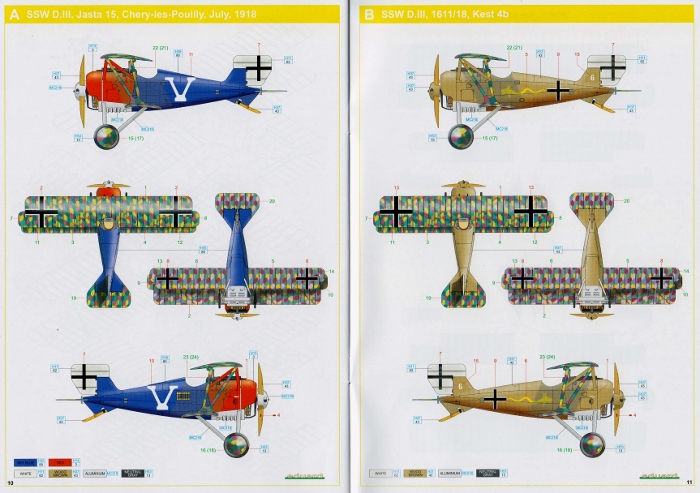|
SSW D.III Weekend Edition

Eduard, 1/48 scale
S u m m a r y : |
Catalogue Number, Description and Price: |
Eduard Kit No. 8484 - Siemens Schuckert D.III
USD$24.95 plus shipping available online from Eduard's website
USD$16.47 available online from Squadron |
Scale: |
1/48 |
Review Type: |
First Look |
Advantages: |
Accurate dimensions; easy to assemble; single piece wings with no distortion and sharp trailing edges; decals in perfect register and minimal carrier film. |
Disadvantages: |
Over scale rib stitching, poor engine detail. |
Conclusions: |
A modern incarnation of an Eduard classic. The latest techniques have resulted in a good fitting kit with sharp, crisp detail. Unfortunately some of it will need removing to allow a true representation of the original. It’s all within the capabilities of the average modeller and the result will be well worth it. The weekend edition of this aircraft gives the buyer a budget priced kit that will still build into a pleasing replica. |
Reviewed by
Brett Green

Eduard's 1/48 scale SSW D.III ProfiPACK is available online from Squadron.com
Weekend edition kits are designed to be budget releases of an earlier packaging.

They utilise the plastic of the originals but omit such extras as photo-etched parts, resin, and masking material. To keep the price to a minimum, decal sheets are smaller and usually cater for a single aircraft.
Inside the box are 2 sprues of dark grey plastic, a piece of acetate film and a generous serving of decals. The 78 parts are well moulded, with ejection pins being kept to areas that are hidden on the completed model. The detail is crisp and sharp with no obvious imperfections.
However, closer inspection reveals that this is not your typical Eduard kit. Unfortunately some of this detail is less than subtle which leads one to believe that much of the work was done by a subcontractor. Subsequent revelations confirmed this.
Overall, the dimensions compare favourably with Dick Bennett’s drawings in Albatros Productions’ Datafile #29. The elevator is a tad smaller than the one represented in the aforementioned publication and the angle of the wing struts also differ by a few degrees. Neither appear as major issues on the finished product.
Construction starts with the cockpit and the 30+ parts really give it a pleasingly “busy” appearance. It’s important to test fit everything before committing any glue as some of the internal “woodwork” can be a little sloppy in the fit department.
The wings are both single piece affairs which greatly eases assembly. The trailing edges are commendably thin and the separate ailerons, elevator and rudder are a welcome feature. Sadly most of the flying surfaces suffer from exaggerated rib tape stitching. This anomaly has to be sanded down. Not even a heavy handed coat of paint or the judicious application of “lozenge” decals will hide these pillars of strength.
Another problem is the engine. The cylinder cooling fins are very poorly done and it comes as no surprise that Eduard have released a resin replacement. The only saving grace is that a lot of the engine is hidden by the cowling, spinner and 4-bladed propeller. The vents under the forward part of the fuselage are opened up which is a nice touch.
To customise the machine, there’s a flare rack, headrest, and a couple of windscreens. The instruction booklet includes a rigging diagram and overall the kit is a very quick and easy build.
Markings
Usually a “Weekend Edition” release gives you markings for a single aircraft.
In this case we are given the choice of 2 options.
-
SSW D.III, flown by Ltn. Vallendor of Jasta 15, July 1918
-
SSW D.III, serial 1611/18, flown by Kessler of Kest 4b

The decals sheets are printed with perfect colour registration and a minimum of carrier film. As well as the national and personal markings, there are logos for the propeller and dials for the instrument faces.

WWI colours are always a contentious subject. Eduard have supplied their version of “lozenge” and it appears that they have gone for a “scale-colour” look. They are cookie-cut for easy application and those on the upper wing exhibit the bolts at the accepted 45 degrees. Interestingly, all of the rib tapes are separate and were not incorporated into the overall design. The struts are not forgotten as patterned decals take care of these as well.
The popularity of this pugnacious little scout far outweighs its contribution to The Great War.
Eduard’s first incarnation was in 1995 and when they announced that a new tooling was in the works, modellers were excited. The result is a kit that is much easier to assemble, has sharper detail, and takes advantage of the latest moulding technology.
Despite the above, the release comes across as an opportunity missed. To bring it up to scratch, there is a lot of over scale detailing to remove. It’s not difficult but it is time consuming. However, when done, the kit will produce an accurate rendition of the original
Thanks to Eduard for the sample and for the images.
Review Text Copyright © 2015 by Rob Baumgartner
Page Created 24 June, 2015
Last updated
24 June, 2015
Back to HyperScale Main Page
Back to Reviews Page

|
